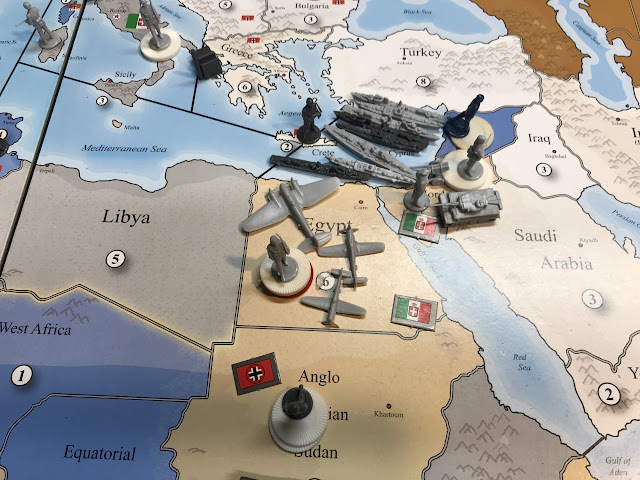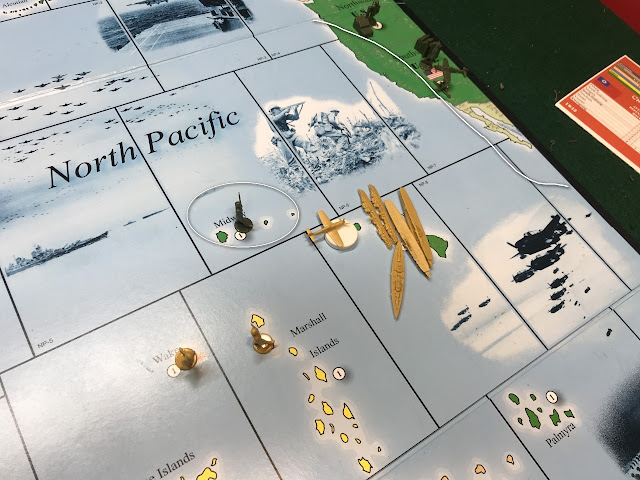A Headless Body Production
Venue: An undisclosed basement
Players: Phil Gardocki running both Axis and Allies.
Game System: The War Game, World War II.
The War Game,World War II, was originally published by Jeffery Stein in 1997.
This version will be using the rules as updated in 2015. See here for the pdf.
For turn 1, see here.
Synopsis:
On turn 1, the Axis made bold moves. Germany briefly taking Leningrad. The Italians taking Egypt, and Japanese securing Peking.
At sea, the Japanese sank major US Naval assets. And the British destroyed one of two wolf packs.
 |
| The situation in Russia at the end of turn 1. |
 |
| The situation in the stormy Atlantic at the end of turn 1. |
 |
| The situation in the Middle East at the end of turn 1. |
 |
| The situation in China at the end of turn 1. |
 |
| The Africa Korps. supported by Italian air, advances from Egypt to the Sudan. Garibaldi, with reinforcements sea lifted in, leads the Italian army into Palestine. |
 |
|
|
It is a timid move. But America has a large force of destroyers that rolled off the rails on the East coast, and is prepared to stomp any U-Boat force the Axis can muster. It is better to be a "force in being" for now, with a potential counter strike later.
 |
| The Germans repeat their attack on Leningrad. |
The Luftwaffe is strong in Finland, and will be reinforced with new builds. The Transport ships new infantry in, allowing the Tirpitz a supporting "Shore Bombardment" strike on round 1.
The result is a strong victory for the Germans. They secure Leningrad and two northern provinces. The only downsides were the Russians were able to "Scorched Earth" the Major Factory, turning it into a minor factory, and Timshenko escaped to Moscow. Where he was promptly executed by Stalin.
 |
| The result in the Middle East is a complete victory for the Axis. The Italians lose just 1 infantry, destroying about 7 Commonwealth Infantry. |
 |
| The Japanese fleet doesn't know what to do. |
There is no enemy fleet to fight. Raiding the west coast seems an option. But the Americans win an attrition war. It was thought to be better to keep the fleet intact for when the American fleet decides to come out and play again.
 |
| But in China, the Japanese army makes serious inroads. |
 |
| The Japanese invasion fleet at Java goes after the remaining Commonwealth fleet in the (very) south Pacific. |
 |
| America launched a lot of ships last turn. 6 Destroyers, 6 Subs. This is reinforced by the Pacific Fleet. |
 |
| Operation Torch is launched. Morocco falls without a loss to the Allies. |
 |
| America launches 6 more subs, and a pair of Liberty ships. |
Also this turn.
Churchill gave into pressure and ordered a Norway invasion. The Royal Navy provided their Carrier and Battleships supporting. Coordination with shore bombardment was poor, and the Canadians were pinned on the beach, and wiped out.
The British also began the strategic bombing campaign on Germany. Germany will lose 13 dollars from the bombing, and a fighter, which cost 14, defending the Reich. But the British lost two fighters as escorts, costing 15 each for 30. And so a virtual tie.
The Americans braved AA fire with their own raid on France. Their bomber survived AA fire, and inflicted 8 dollars in damage to Germanys production next turn.
Strategic bombing works like this. First there is an intercept round where only fighters, bombers and artillery (AA) fight. Surviving bombers then cause 2 die 12 worth of damage to the next turns production from that province. This damage has an upper limit equal to 1/2 the production of the province, plus a bonus for it's factories. +2 for Minor Factory, +20 (!) for major factory.
So in Germany, their production is 20 and a Major Factory. The limit of Strategic bombing is 30. 1/2 of 20, + 20. In France, with a Minor Factory, it is 8. 1/2 of 13, rounded down to 6, plus 2.
So Strategic Bombing is more about finding a good target than having overwhelming bombers.
No comments:
Post a Comment